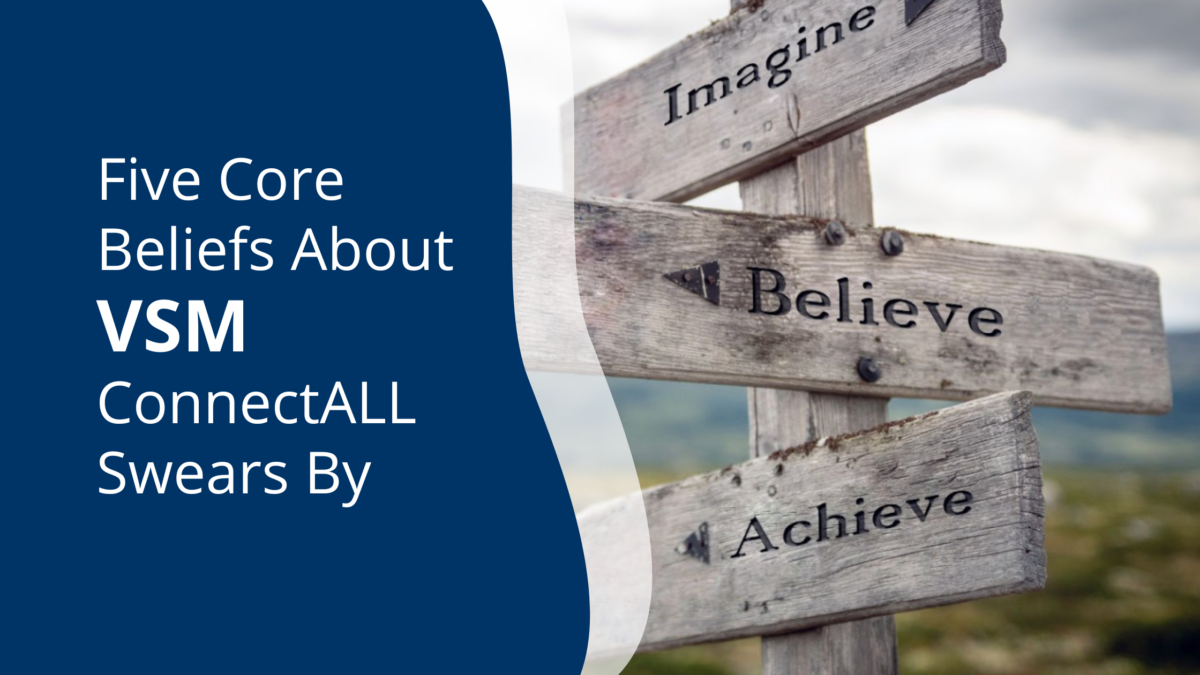The software industry is overwhelmed and is drowning in thousands of value stream management (VSM) definitions — some are broad and some are vague. In the last couple of years, the market is also flooding with new vendors who claim to provide VSM solutions to drive agility and velocity and accelerate software delivery — some of which are not even complete solutions.
Having worked in the B2B SaaS space and specifically practicing lean methodologies like VSM for over two decades, ConnectALL’s influencers and thought leaders have been advocating the correct understanding and adoption of VSM in the software industry.
In August 2020, ConnectALL SVP of Products Andrew Fuqua started talking about what value stream management isn’t and continued to clarify what it should not be perceived as. He said VSM:
- isn’t the same as a value stream
- isn’t a defined process
- isn’t a tool or a platform
- isn’t the same as value stream mapping
- isn’t the same thing as DevOps, Agile, Scrum, Lean, or Kanban
- isn’t just project management
- is a bit of a misnomer
In a webinar, exactly two years later in August 2022, Andrew and Lance Knight, President & COO of ConnectALL shared, in a very succinct way, what ConnectALL believes value stream management is and how it can help your organization and when you’re going to choose a value stream management platform what’s important for you to look for.
Here are the top five core VSM truths that ConnectALL swears by:
1. Value stream, value stream mapping, value stream management, and value management are all different but related
Lance: There’s a messaging problem that’s going on here with value stream management and this is Andrew’s statement (as mentioned below). Has your opinion changed or do you feel the same way, Andrew?
“There’s nothing wrong with value stream management (VSM) itself, but there’s plenty wrong with how it’s being considered and discussed by others, who often conflate it with either Agile or value management. They’re not the same thing.” — Andrew Fuqua, SVP of Products, ConnectALL
Andrew: I believe the point is still the same. I think people are still confused we have these three terms or phrases and they all sound very similar value stream, value stream mapping, value stream management, and value management. And even I sometimes have to stop and make sure I include or exclude the right word to make sure we’re conveying the right thing. It’s really easy to get a little sloppy and leave off the term “management” or to conflate “value management”, “value stream management” or to be talking about the “value stream” and include the other word. And that just creates a lot of confusion and I think a lot of people still in the industry are unclear about the differences between these.
Lance: There’s still that uncertainty about it that drives some decisions on how to get involved. So when you think about this, this is what I’ve heard customers say, “well, it seems like a buzzword. What does this mean to me? Why do I want to get involved in this and how can I leverage these principles and thoughts and products and platforms and what’s the difference between a platform and value stream management?” Customers themselves are confused about what It can do for their organization. Value stream management has been around for a long time and we have a set of beliefs that we want to talk about.
2. You don’t need to create a value stream, you already have them
Lance: A value stream can be defined as value-added and non-value-added activities required to take products or services from raw materials to the waiting arms of the customer.
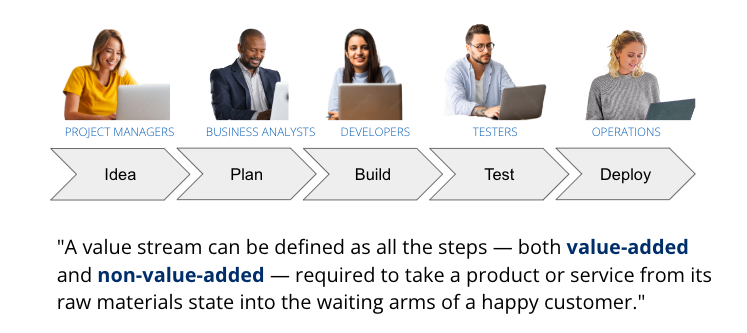
Andrew: Some people think that they need to start having a value stream or they need to learn how to put a value stream in place. The point is that you’ve already got a value stream if you’re an ongoing enterprise, if you’re making some money, their value streams are there. Now, you might not have identified them and you might not have been managing them. But the value stream is the basic thing, from end to end, how value is produced in an organization.
[Watch the full webinar: You’ve Heard What Value Stream Management Isn’t. Now Hear the Truth About What It Is]
3. VSM is Human and is all about improvement
Consider looking at the below image and try understanding how this relates to value stream management and how managing a value stream is a human endeavor.

Andrew: Take a look at this guy who is in a theater. He can see his lines and queue sheets, and he’s helping manage or direct this play. And so he’s a human and he’s paying attention, he’s observing, he’s understanding what’s going on and directing the flow of the play there on stage. And so it’s a human managing the flow of value.
Lance: So that gets us to those beliefs. Value stream management is human.
Andrew: It’s a human endeavor. It’s a human process. It’s a human activity. It can’t be automated away. It can’t be put into a machine or into a platform in such a way that you can remove the humans. And the thought processes the humans have to go through, which kind of leads us to detail out what it is.
Lance: Value stream management as a concept is an age-old thing that’s been around since the 50s. It’s what humans do. And a platform is here to help humans, but it’s humans working together to better manage the value streams.
Andrew: The key point there is value stream management is all about improvement. It’s the same as the Kanban method. A lot of people will put up a Kanban board and stop doing Scrum and say they’re doing Kanban, but all they’re doing is not Scrum. If you miss the improvement part, if you miss understanding the flow, taking a look at the metrics, and doing the Kaizen to improve what you’re doing, then you’re not doing the Kanban method. And it’s the same thing. Value stream management is a way to do the improvement. So if you’re not focused on continuous improvement, you’re not doing what value stream management is.
Lance: In value stream management, we’re looking at how long something takes in a moment and figuring out how to remove non-value-added activities in the framing of waste.
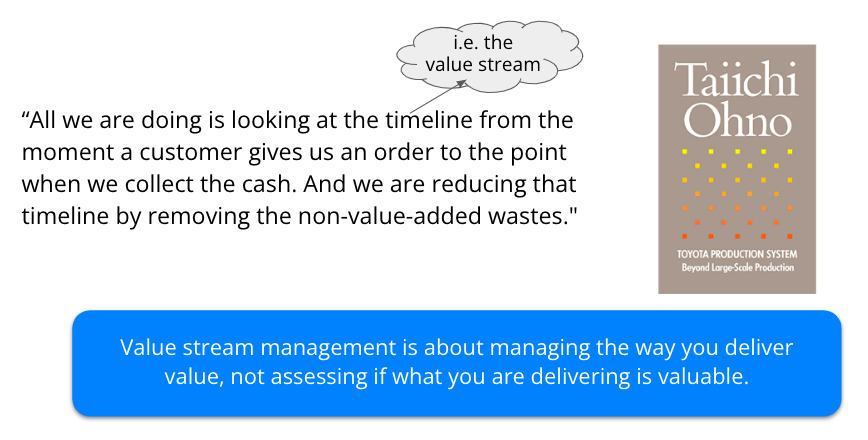
Andrew: And this is all about the time, reducing the time, and improving the flow. Notice that there’s nothing here about the value itself. Another way to put it is that value is assumed. It’s assumed that you’re putting valuable work through your value stream. But value stream management is about improving the flow and there’s something else that is about the value of the stuff that’s going through it.
Lance: The value stream doesn’t care whether what you’re putting through it is valuable or not. It assumes this because it’s a request from the customer. So it’s valuable what you’re building to the customer because they’ve asked you to do it. This is value stream management.
The 8-step process of Value Stream Management
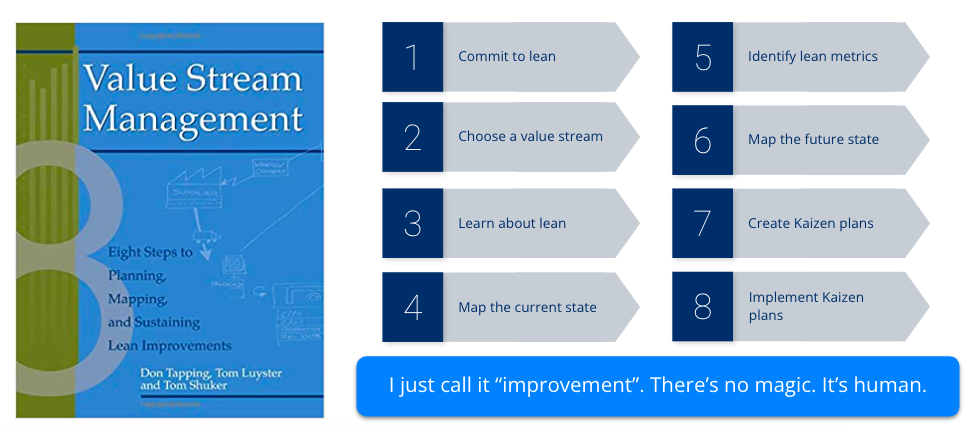
Andrew: Try understanding the eight steps to value stream management from this perspective — it focuses on improvement. It’s the things that you need to do to improve your value stream — understand the value stream, identify it, understand lean, match your current state, measure it and — then there’s an implied in here — decide a direction for improvement and map out the future state based on — what is implied — the direction that you need to take to improve upon — make your improvement plans and implement them and then repeat. And so it’s very much a human endeavor. Again, all of these things are human steps that you have to do. You have to keep your brain engaged, evaluate these things, make decisions, and then implement them. You can’t tool all of this stuff away.
Lance: And this is the outcome you can get or the results of having good value stream management and software development and delivery — deliver higher quality, lower cost by streamlining flow — the flow of artifacts, moving the flow of people and processes, and how this stuff works in every value stream today. It starts with an idea that gets broken down into initiatives. That gets broken down even further into user stories, tasks, releases — all of this happens — and part of that is managing the flow of those things, going through your value stream to give the outcomes that people want, which is the delivery of some piece of code in production that does what the business needs for it to do.
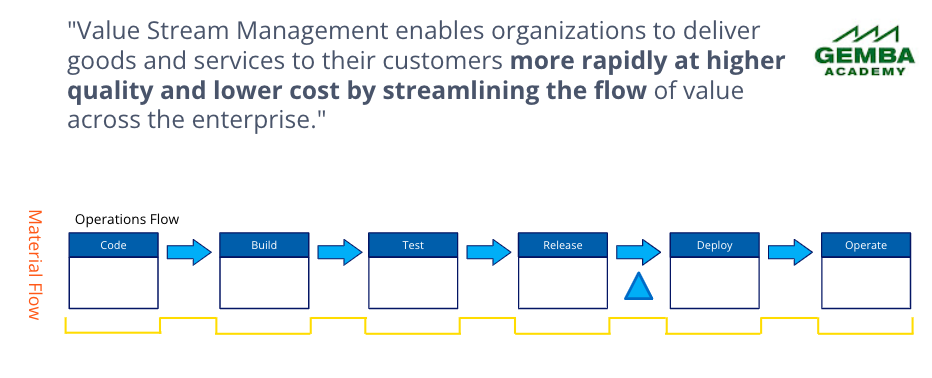
Andrew: Although it (the above image) mentions the word value, their value is assumed. The focus is not on “are you sending value through”, the focus is on “whatever you send through is it going to go through with low cost and rapidly”.
4A. Value management is getting valuable work through the value stream
Lance: The goal of value stream management is to deliver the most value at the lowest cost, and determining what’s valuable is up to the business.
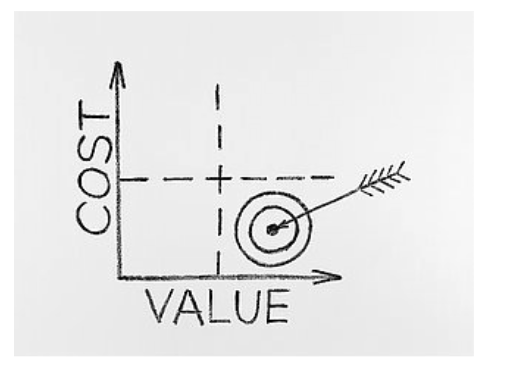
And are some things we put together quickly about making work visible:
- only visible work is valuable and what the customers want
- minimizing cost
- balancing the stake of the needs of all the stakeholders
Andrew: It’s all about choosing work, understanding your strategy, making sure that you get valuable work through and that you can get it in with minimal costs. So you see here (in the diagram above), this is just both sides of the value and cost equation — I guess you could say the financial side of it about choosing the work that you send through the value stream. This is not about the value stream itself. So we have the value stream, we have to manage the value stream, and then we have the value of what you’re putting through the value stream. And so these are three separate concepts though they’re related. But it’s valuable work, minimal cost, and considering the needs of all your stakeholders and that’s value management.
Value management and value stream management are related because the value goes through the value stream which you manage with value stream management. So they’re both tied to the value stream. One is managing the value stream and the other one is paying attention to what you put through it.
Lance: Making sure that what comes out of it is the value that was expected from it.
4B. Organizations have to do both value management and value stream management
Andrew: So we’ve got value management and we got value stream management. Which one do I do, and how do I choose?
Lance: I think the truth is you’re doing both right now. You’re deciding somehow with something that what this is is most valuable. Now whether you have visibility to that, whether you can see what’s going through is valuable or not, or you understand where those valuable things are in the value stream, that’s a different story. But, organizations have to do both. And this is why organizations understand that they have a portfolio team that’s deciding based upon all types of things — whether those are customers, markets, whether those are revenue or demand or whatever those areas of what you think is important to you, say we call those pieces of a strategy — are being put through there and you have to put it through efficiently and deliver it predictably on time with lower cost.
“Our core beliefs on what value stream management and what value management are helps us work together to define what ConnectALL products will be. We use these beliefs to make sure that we can assist humans with these things on our platform. And that’s kind of what we believe a platform should be able to do.” — Lance Knight, President & COO, ConnectALL
5. A VSM platform gives you the power of connections and allows you to do both VSM and value management
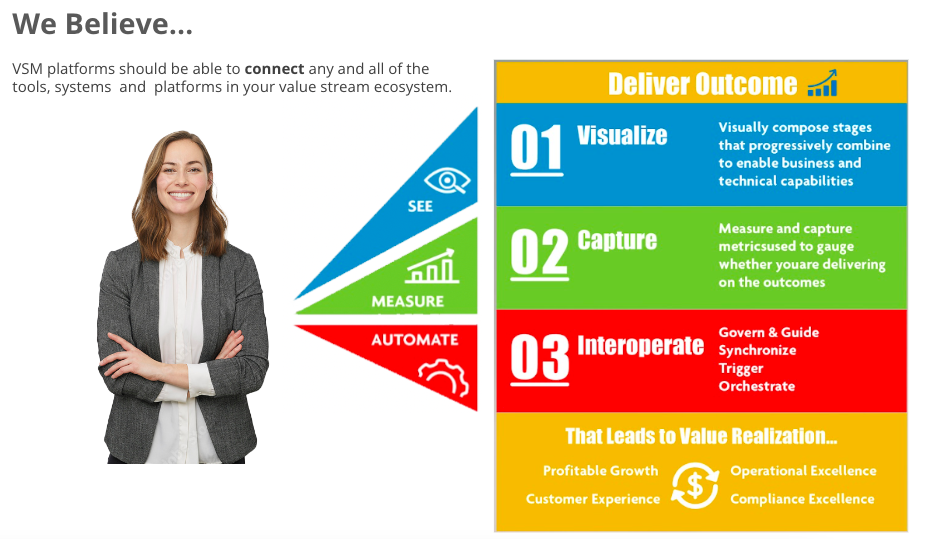
Lance: Our core belief here is that we can connect. We can connect all the tools for various things — we can connect to synchronize, trigger, and monitor. The value stream management solution should sit over top of all of the things that are going on across all those tools and facilitate the flow of artifacts through those. And it does it through connection. You can have the best in class, prettiest graphs in the world on a value stream management intelligence tool. But if you can’t get data by connecting, then you’re not getting any beautiful charts. So it’s the power of connections, it’s the power of integration that drives our value stream management platform. And if you’re looking into one, you should consider that as a piece of the whole pie and puzzle of how you’re going to get value through.
Andrew: The ability to connect and get the data is the basic enabler of the value that a platform would give you. I think it’s the most crucial starting point from which we can get the other things.
Lance: You gain visibility because I’m connecting all the tools and I can see where things are flowing and you can see that both within the value stream views that can be created and within the metrics and how you can see whether you’re being efficient. I can understand all the things that are in the backlog of what’s going into the value stream at the portfolio level because I’m connected to it. Then I can run analytics on that to let me know “am I delivering something of value, what valuable things am I putting in, and are those connected to my OKRs, to my business outcomes?” At the same time, these same connections allow us to enforce governance — we can interoperate, we can connect, we can trigger. The most important piece of what a value stream management platform needs to be able to do well and efficiently is to connect all the tools you’re using to develop software.
Andrew: That allows the human to take it from there, to do the things that only the human can do. So the tool can help you or the platform can help you see what’s going on, can help you measure the flow, can help you measure the value. The humans can then take that, understand what’s going on and do the value stream management steps where you identify a value stream, you pick an improvement, you make your Kaizen plans and you implement those plans. And as you do that, you’re probably going to end up automating some tasks, automating some synchronizations or some triggers, as well as perhaps collecting more data and improving the measurability of your value stream, feeding back into the human process of managing and improving the value stream, the thing that only a human can do.
Lance: It gives the information needed to improve your value stream by looking at your human processes too, which teams are developing better quality software to understand that and then go look and see why or what’s going on. Work gets broken down into different pieces and delivered across multiple value streams and it’s about connecting those. I can make sure governance is happening, we can either automate that or do things with it. It’s getting all these things —connected — that you’re using into a platform that can help with flow and that reduces cost, that tells you whether you’re aligning to your business outcomes and moving forward.
ConnectALL can give out value stream insights, those are the rich analytics. And we put that together because we knew that companies need those metrics, they need those visualizations across the whole value stream both individually and down to teams. Like recently we just introduced the concept of teams inside of ConnectALL to support things like SAFe. So you can organize around teams and have different value streams around teams and have team-based analytics, but at the same time, you’re going to need business-based analytics. Decide what am I putting into those teams. That’s the strategic view we’ve been talking about and how that helps organizations decide what’s more strategic and tying those two, even a higher level value stream tools, which let us know how much budget is being consumed by all those different teams and so on.
Andrew: When we talk about value stream management as well as value management, we’re talking about the whole value stream end-to-end — from ideation, through your budget planning, your making product teams, through the decomposition of work, from your objectives or your initiatives, through your ethics, through your stories and then on through your code commits, through your build, to your deployments, to your support organization and your services organization as well. It’s multiple organizations in multiple value streams, in a portfolio of value streams. And you need to enable or help people at each part of the organization with responsibility over each one of those sub-value streams, so to speak, manage and improve the flow as well as improve the value that flows. So that’s what we’re talking about here really not neglecting any particular part, not a focus only on DevOps, not a focus only on Agile, not a focus only on Portfolio to the exclusion of the people at the ground doing the individual contributor work. And often what we see in the industry is people neglecting the ITSM, the support team, and the operations team. We need to encompass all of that and the platform needs to go fully from end to end.
Lance: Including DevSecOps and monitoring tools — so that the leader in the organization will have visibility as never seen before, where you know that, this is a side effect of what we do. But audits become just a matter of fact because of the way you can connect all these things within your visualization and in your hierarchy, a full hierarchy representation of what you just talked about. Idea from code to production. Why would this product, if this gets in there, you can see that and this unmet before traceability that we’re able to give to and then automate that throughout? That’s where the automation plan comes in.
Four major things that the ConnectALL VSM platform allows you to do:
- Trigger activities
- Monitor
- Capture data
- Synchronize
No matter what solution you’re using, we connect to it to provide these analytics and then automate things as they’re going through.
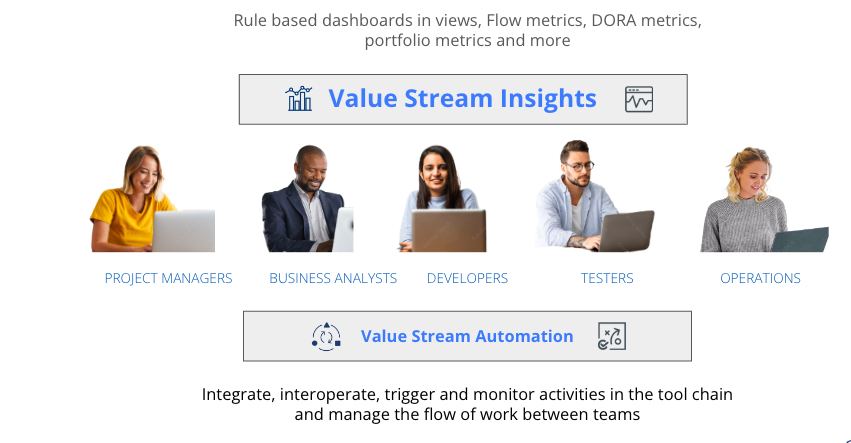
ConnectALL has three products — but our true major products are ConnectALL Automation and ConnectALL Insights. It’s intertwined and how they work together. The other product we have is a free value stream mapping tool that you can go use for free if you want to start mapping your value stream today at valuestreammanagement.com.
[Watch the full webinar: You’ve Heard What Value Stream Management Isn’t. Now Hear the Truth About What It Is]
Have specific questions about VSM, contact Lance Knight at lk*****@co********.com and Andrew Fuqua at af****@co********.com.
If you are ready to accelerate and build everything more efficiently, contact our specialized sales representatives, who will guide you on the path of predictability.

Head of Content Marketing at ConnectALL, responsible for communication and content marketing strategy. For two decades, I’ve assisted businesses to integrate content marketing into their marketing plans to achieve their business goals. I specialize in creating and developing content (inbound and outbound) across various online and offline channels from websites, blogs, and social media to email marketing and marketing communication collateral.

